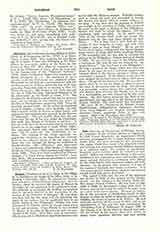

Salazar, DOMINGO DE, b. in La Rioja, in the village of La Bastida on the banks of the Ebro, 1512; d. in Madrid, December 4, 1594. He entered the Dominican monastery of San Esteban, Salamanca. Sent to Mexico, where he received the degree of Master in Theology, he was appointed to the professor’s chair. His ambition to evangelize the heathen was granted and he devoted himself to the conversion of the natives in the Province of Guajaca. He was characterized here by the same zeal for defending the rights of the Indians that he manifested later in an heroic degree in the Philippines. Salazar was next transferred to Florida, where he passed many years in toil and privation. From Florida he was recalled to Mexico to be prior of his convent and vice-provincial of his order. After forty years of missionary life, he was sent to Madrid on important business connected with the Mexican mission. Political enemies tried to thwart his work and succeeded in having him thrown into prison when he sought audience of the king. It was then that his presence in Madrid was brought to the attention of Philip, who proposed his name to the pope as Bishop of the Philippines. Salazar was loath to accept the dignity; but his missionary spirit prevailed. As he wrote later: “One of the reasons which made me accept this bishopric was the fact that these Islands are near China….For a long time I have had the conversion of that kingdom at heart, and with that thought I came to these Islands”. He set out for his see via Acapulco, taking with him twenty Dominicans, twelve of whom died before reaching Mexico; of the remainder only one was able to continue the journey to the Philippines. Salazar arrived in Manila in 1581. He espoused the cause of the Filipino with a fearlessness that won for him the titles of the “intrepid Salazar”, “the Las Casas of the Philippines”. He held a synod of the clergy, which was later confirmed by the pope, erected a cathedral, regulated the internal affairs of the diocese, opened a college, and established a hospital. In his charity to the poor he even pledged his pectoral cross to relieve their necessities. Old age did not lessen his zeal. He was almost eighty when he set out for Spain to plead in person the cause of the natives with the king. His mission was successful; various abuses were corrected, three new dioceses were created, and Manila was elevated to a metropolitan see with Salazar as its first archbishop. He died before receiving the Bull of his appointment and was buried in the Church of Santo Tomàs, Madrid. His tomb bears this inscription: “Hic jacet D. Fr. Dominicus de Salazar Ordinis Praedicatorum, Philippinarum Episcopus, doctrina clams verus religiosae vitse sectator, suarum ovium piissimus Pastor, pauperum Pater, et ipse vere pauper. Obiit 4 die Decembris anno 1594.”
PHILIP M. FINEGAN

